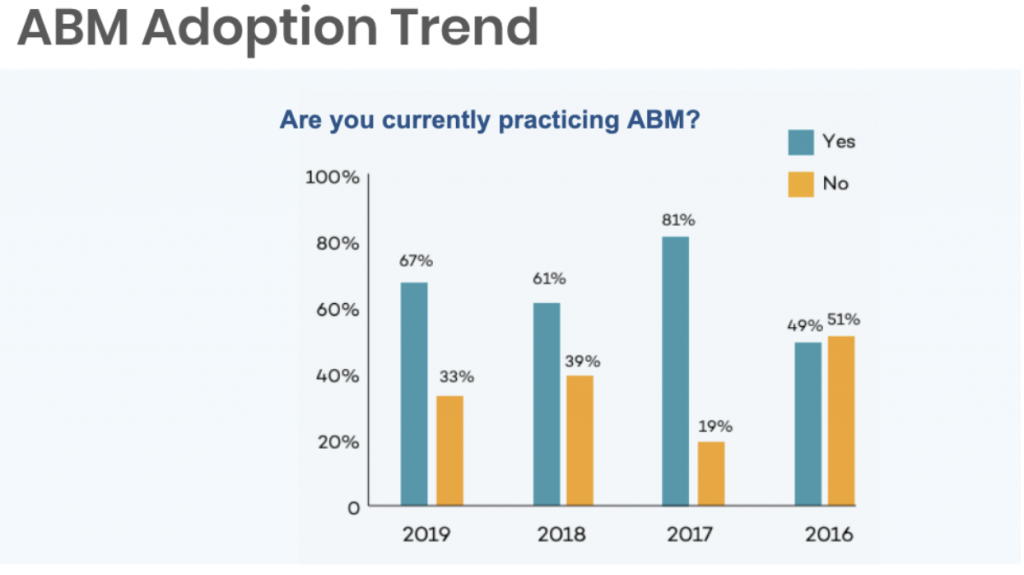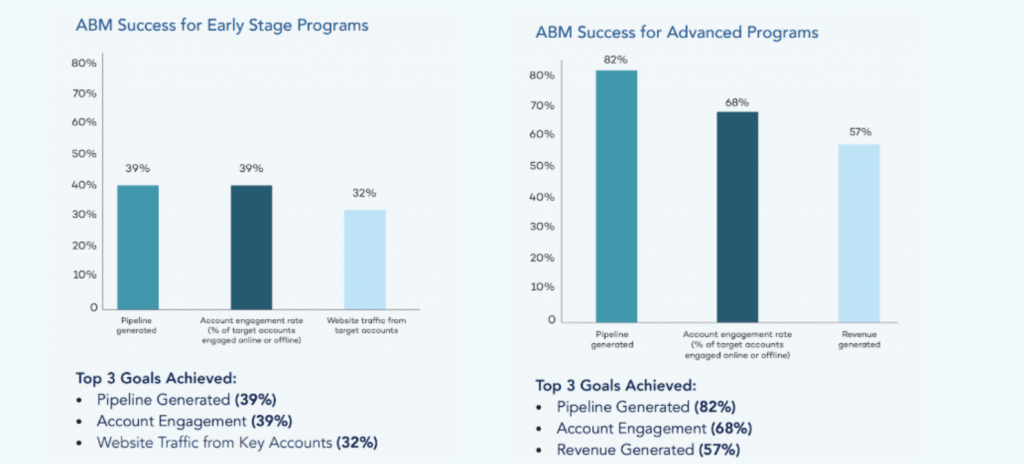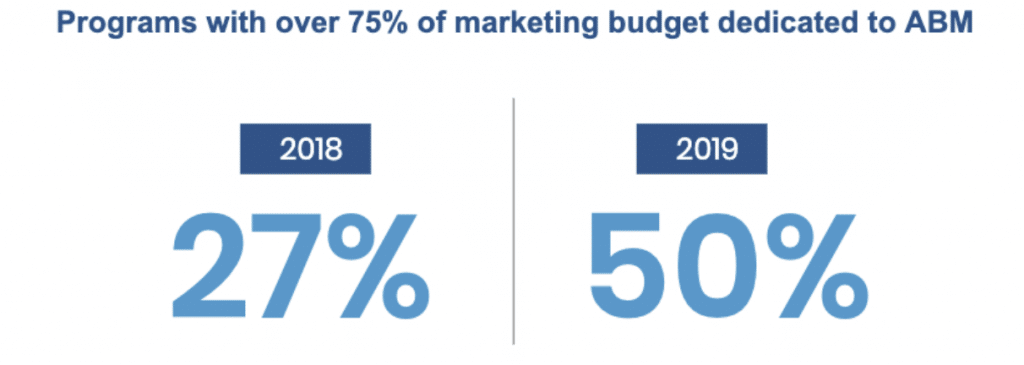It’s safe to say that 2020 is the year that B2B Marketing changed forever. Live events are now a distant memory. Marketing budgets are being cut by an average of 44%, according to Gartner. Most B2B professionals are now working from home. It’s a wildly different environment than the one we started the year with and we expect that to show up in our fifth-annual State of ABM report. [Take the 2020 State of ABM Survey here.]
With four years worth of data under our belt, we expect this to be the definitive report on how modern marketers have adapted their marketing strategies in a post-COVID world. With that on the horizon, we thought we’d take you through some of the trends we’ve seen up until the end of last year, and throw a few predictions for what we expect to see in the coming year.
Account-Based Marketing Is Here for the Long Haul
Way back in 2017, 81% of companies said they were practicing ABM. This is when the hype machine was on maximum overdrive, leading marketers to believe, “if I just buy an ABM tool or two, my revenue challenges will be solved!” Then the realization set in that great technology does automatically make an account-based program successful. There’s a lot of work (namely team alignment) that goes into an account-based transformation that many weren’t prepared for.
In 2018, that number fell off a cliff and dropped to just 61%. Skip to the end of last year and we’re at 67% of companies actively practicing ABM.

With a modest increase of 6% last year, we’re seeing stabilization in adoption, indicating that companies understand what goes into this paradigm change and are committing to it.
Will we ever see 100% of companies practicing ABM? Trick question. The answer is yes, but we won’t call it “ABM” anymore. As marketing teams compete in increasingly crowded spaces with finite resources, a lot of what we call “ABM” will become synonymous with just “marketing.” Practitioners and vendors alike are now on the other side of the trendiness curve; it’s just a matter of time before we stop calling it “ABM.”
2020 Prediction: The number of respondents practicing account-based marketing will continue to rise. We also expect to see expanded tech stacks, notably in account-based advertising, as well as measurement and attribution.
Brand Is the New Demand
It’s so refreshing to hear marketers talk about building great brands again. According to Gartner, it’s now the most vital marketing capability for businesses, beating out analytics and operations. For the past 15 years, marketing teams became obsessed with pure data. They took their eye off of their brand to focus on quick, direct response campaigns that helped in the short run (but did nothing to benefit brands). But from last year’s survey, we now see that while direct response campaigns work in the short term, brand marketing efforts have a higher ROI in the long term.
It’s no longer an option: Marketing leaders must now focus on their brand – just not too much. We found a 60/40 split between brand and direct response yields the highest return. But for most CMOs, spending more time creating immersive experiences and less time in CRMs and pivot tables is exciting news!

2020 Prediction: “Lead generation” as a goal for ABM programs will continue its descent (it was a goal for 8% of respondents last year) and “pipeline generation” and “revenue generation” will continue to rise as the main KPIs. Underpinning those shifts, revenue teams will focus on creating great experiences for ever-tightening segments.
ABM Will Become a Matter of Survival
If you’re dabbling with the concept of reorganizing your team and reallocating your budget for named-account programs, we salute you. Get to work though, because if your competitors have a sturdy, proven-out account-based program, they’re generating more than twice the pipeline you are. Unless you’re climbing up the ABM maturity curve quickly, you’ll soon be outpaced, and the gulf between you and your competitors will only get wider.

2020 Prediction: We’ll see ABM adopted across a wider variety of marketing activities – most notably around customer retention and expansion initiatives – as revenue generation becomes the guiding light for CMOs and net-new acquisition becomes more difficult.
More Budget Is Going to ABM (But Is It Enough?)
Last year we found that 50% of all companies were dedicating over 75% of their budget to ABM efforts. That signaled a bigger investment in raw headcount and not just more tech and bigger ad budgets, which is precisely what we want to see. When we saw the huge drop in ABM activities in 2018, it was because people weren’t ready for the organizational transformation that ABM represented.
Aligning outbound teams to marketing, building new dashboards with data-sharing frameworks to keep sales and marketing in lockstep, and reorienting demand generation’s day-to-day activities are some of the significant, uncomfortable shifts that companies are going to have to go through. Now that we’re seeing an increased investment in headcount, companies are figuring out how to make ABM a top priority and staffing appropriately to support their new marketing programs.

If ABM 2020 is synonymous with B2B marketing, shouldn’t all budget dollars be ABM budget dollars? If we continue to treat ABM separate from our other marketing activities, it will hold all companies back because it will feel like a disparate marketing motion and not a foundational commitment to being better at marketing.
2020 Prediction: While we expect to see overall marketing budgets go down, the amount dedicated to account-based activities on a relative basis will go up again this year.
The Big 2020 Prediction: This Is the Year Marketing Changed Forever
It’s been about 15 years since marketing automation became the standard tool for B2B marketers. Not a tremendous amount has changed for B2B marketers since then. While the world around us is in upheaval, it’s a very interesting time to be a B2B marketer. Finally, massive shifts are happening in the ways we go about growing our organizations and COVID has been a massive accelerant to that change. Whether or not every B2B marketer wants to take part in that shift is up to them. With a decreased focus on lead generation, which is increasingly becoming a fool’s errand in 2020, we’ll see today’s best marketers double down on brand building and creating personalized experiences for their most important audiences.